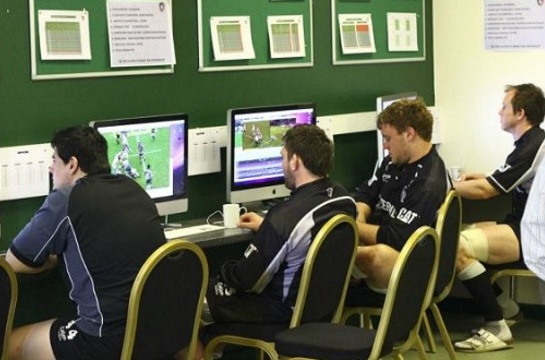
Players analyzing data after a match.
I sat with an international coach recently on the morning of a big test match and we talked a bit of rugby.
He mentioned that their analysis had identified a flaw in the opposition’s play that they were hoping to exploit later that evening.
It got me thinking about the massive influence match analysis has in the modern game, and like all technology, how far it has come in a relatively short space of time.
The Rugby Site
The early pioneers of match analysis, in the late 80s and early 90s, were coaches who were wanting to clip passages of play in order debrief their own team performances.
The technology was simply two VCR units linked together and a coach willing to commit the time to push play, pause, play, record…repeatedly!
South Africa had one of the first computer analysis systems for rugby. Transvaal developed a system whose software had its earliest origins in Israeli military defence.
The first sporting adaptation of this software was for the Israeli basketball team, then it was picked up and used extensively by the U.S professional basketball teams within the NBA.
In the early 90’s Transvaal adapted this basketball system to rugby and the analysis race in rugby was on.
Meanwhile, George Serralach a football-mad Spaniard and a mathematical genius, had developed an analysis system for football but had struggled to get uptake from the game he loved.
In the mid-late 90’s he was introduced to one of the greatest rugby minds of all time – Wayne Smith – and then some magic happened… Wayne broke the game down into its component parts, then George pieced it together into code.
The company Verusco was born and would have a massive influence in the future of rugby match analysis, particularly in the Southern Hemisphere.
In the Northern Hemisphere businesses like Pro-Zone were leading the pack. While coaching at Northampton in early 2000 we were fortunate to be the only Premiership Club that had the same system the RFU had installed for England at Twickenham.
18 cameras were installed around the stands at Northampton’s Franklins Gardens and each camera was responsible for one 18th of the field. The system utilised the highest tech in feature recognition software of the time.
Every Monday morning, we coaches would receive full statistics – both team and individual – with the relevant video of the skill eg. tackle, clear out, line break etc. There was also a rating on physical effort including percentage and second/minute summaries for each player identifying game time spent walking, jogging and full pace.
Since this early adoption in the early 2000s major technological advancements have been made in areas such as GPS tracking and heart rate monitoring, increasing accuracy and standards of measurement.
There has been a huge investment made by nations and professional clubs in specialist analysts, who with the help of the coaches, have been able to cut through the data provided by these systems to identify and measure the 5-10 key things that they believe win and influence outcomes.
This specialist human resource has developed quality ratings to give true depth and meaning to the statistics, that are now able to be delivered in real time and are shaping the in-game and half-time messages like never before.
You won’t see a professional club or international coaching box without the team analyst present.
The influence of match analysis systems and analysts within the game of rugby in the past 20 years is profound. At the highest end of the game, test match rugby, week-to-week game plans are based around video analysis of the opponent.
The most in-depth analysis delivers professional clubs and international team’s insight into even the smallest chink in the opposition’s armour.
That tiny insight can then provide an opportunity significant enough to build a crippling attack plan that results in a win.